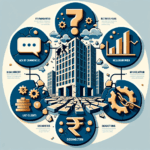What is the role of technological disruption in causing business failures?
Remember the time when Kodak was synonymous with photography? Or when Nokia was the king of mobile phones? Their stories serve as a stark reminder of what happens when businesses ignore the tidal wave of technological change. This phenomenon, known as technological disruption, is not just about a new gadget or software; it’s about technology that fundamentally changes how an entire industry operates and reshapes what customers expect. For business owners across India, from bustling metros to Tier-2 cities, understanding the direct link between technological disruption business failures is no longer optional—it’s crucial for survival and growth. This isn’t a problem reserved for giant corporations; it’s a critical, everyday challenge for Indian MSMEs and startups. In this article, we’ll explore the root causes of these failures, look at real-world Indian examples, and provide actionable strategies to help your business not just survive, but thrive in this new digital era.
The Core Causes of Business Failures Due to Technology
Failure in the face of technological change rarely happens overnight. It often stems from a combination of internal resistance, a misunderstanding of market shifts, and an inability to adapt legacy systems. The technology itself isn’t the killer; the failure to embrace it is. Let’s delve into the core causes of business failures due to technology that can cripple an otherwise successful enterprise. Understanding these tech-specific issues is vital, as they often compound the What are the most common reasons for business failure?.
Failure to Adapt to Changing Consumer Behaviour
The modern Indian consumer is digitally savvy, pressed for time, and expects convenience above all else. The impact of technology on businesses India is most visible in this seismic shift in customer expectations. Businesses that fail to adapt to this new reality are often the first to fall. The demand has moved from traditional offline experiences to seamless online interactions. Customers now expect on-demand services, whether it’s getting food delivered in minutes, booking a cab from their smartphone, or receiving an e-commerce package the next day. The rise of UPI has made digital payments the default, and businesses still insisting on “cash only” are increasingly seen as inconvenient. A company that forces customers to visit a physical store for a task that could be done online is creating unnecessary friction, pushing them directly into the arms of a more tech-forward competitor.
Holding on to Outdated Business Models
A business model that was profitable for decades can become a liability in a matter of years. Technological disruption creates entirely new ways of delivering value, making traditional models obsolete. The most classic example is the demise of physical media like CDs and DVDs at the hands of streaming giants like Netflix and Spotify. The business model shifted from owning a physical product to subscribing to a vast library of content. In India, we see this playing out in retail, where traditional brick-and-mortar stores are competing with direct-to-consumer (D2C) brands that sell exclusively online, cutting out the middleman. Aggregator platforms like Zomato or Urban Company have completely changed the restaurant and home services industries by creating a new model that connects consumers directly with service providers, offering choice, transparency, and reviews—features that traditional models couldn’t match. Sticking to an outdated model because “it’s how we’ve always done it” is a direct path to irrelevance.
Operational Inefficiencies and High Costs
Running a business with manual, paper-based processes in the digital age is like trying to win a race on a bullock cart against a sports car. It’s slow, expensive, and prone to errors. The burden of manual inventory management, pen-and-paper accounting, and handling customer queries one by one over the phone drains resources and prevents growth. Competitors who leverage technology can operate with far greater efficiency. For example, using inventory management software prevents stockouts and overstocking. Accounting software like Zoho Books or Tally on Cloud automates invoicing, tracks expenses, and simplifies GST filing, reducing both costs and the risk of compliance errors. To get started on this path, you can learn how to Set Up An Accounting System for My Small Business. The technological changes affecting Indian industry demand leaner, more agile operations, and businesses weighed down by manual inefficiencies simply cannot compete on price or speed.
Ignoring the Power of Data
In the 21st century, data is the new oil. It is the most valuable resource for understanding your customers and making informed decisions. Yet, many businesses continue to operate on guesswork and intuition alone. Failure to collect, analyze, and act on data is a critical misstep. Every customer interaction, website visit, and online sale generates valuable data. Are you tracking which products are most popular? Do you know where your website visitors are coming from? Are you analyzing customer feedback to improve your services? Without this information, you are flying blind. Your competitors, on the other hand, are likely using data analytics to personalize marketing, optimize their pricing, and predict future trends, giving them a significant strategic advantage.
Case Studies: Technological Disruption Business Failures in India
To bring the concept home, we don’t need to look at foreign examples. The Indian market itself is a living laboratory of disruption. This section will look at real-world examples, highlighting the reality of technological disruption business failures India has witnessed firsthand. These stories underscore how quickly market leaders can be challenged by innovators who leverage technology effectively.
Unorganized Retail vs. E-commerce Giants
For generations, the local Kirana store was the backbone of Indian retail. However, the arrival of e-commerce giants like Amazon, Flipkart, and now JioMart presented an unprecedented challenge. The disruptive factors were clear and compelling for the consumer: a virtually unlimited selection of products, competitive pricing driven by massive scale, deep discounts during sales events, and the unparalleled convenience of doorstep delivery. Many traditional Kirana stores, which relied on personal relationships and proximity, found their sales dwindling as customers shifted their spending online. However, the story doesn’t end there. The smartest among them are now adapting. They are using platforms like Dunzo and Swiggy Instamart to offer local delivery or creating their own simple systems through WhatsApp Business to take orders and accept digital payments, blending their traditional strengths with new technology.
Traditional Taxis vs. Ride-Hailing Apps
The classic ‘Kaali-Peeli’ taxis of Mumbai and Delhi were once the undisputed kings of urban transport. Then came Ola and Uber. The disruption they caused was swift and total. The core problems with traditional taxis—haggling over fares, frequent refusals, and uncertainty of availability—were all solved by technology. Ride-hailing apps introduced a revolutionary new experience built on:
- Price Transparency: Know the fare before you book the ride.
- Convenience: Book a cab from anywhere using a smartphone app.
- Digital Payments: No need to fumble for exact change.
- Safety & Tracking: See your driver’s details and track your journey in real-time via GPS.
This superior customer experience, powered entirely by mobile technology and data, quickly made app-based cabs the preferred choice for millions of Indians, leaving many traditional taxi drivers struggling to compete.
Print Media vs. Digital News Portals
The familiar sight of the morning newspaper is becoming less common as readers increasingly turn to their screens for information. The technological changes affecting Indian industry have hit print media particularly hard. Digital news portals, social media feeds, and mobile apps deliver news instantly, often for free, and with multimedia content like videos and podcasts. This has led to a steady decline in the circulation of physical newspapers and magazines. More importantly, it has diverted the river of advertising revenue. Advertisers who once spent heavily on print ads are now pouring their budgets into digital platforms like Google, Facebook, and Instagram, where they can target specific demographics with precision and track their return on investment—something print ads could never offer.
How to Leverage Technology for Business Sustainability and Avoid Failure
The threat of disruption is real, but it’s crucial to remember that technology is not just a threat; it is also the most powerful tool for growth and resilience. The key is to be proactive, not reactive. This section focuses on the proactive role of technology in business sustainability and provides actionable steps that small and medium-sized businesses can take to secure their future.
Embrace Digital Transformation on a Budget
Digital transformation sounds expensive and intimidating, but it doesn’t have to be. For a small business, the journey can start with simple, low-cost steps that deliver an immediate impact. You don’t need a massive IT department to begin.
- Build Your Digital Foundation: Start with a professional-looking website that clearly explains what you do. Create a free Google Business Profile to ensure you show up on Google Maps and local search results. Establish a presence on the social media platforms where your customers are active.
- Use Affordable Software (SaaS): Leverage the power of Software-as-a-Service (SaaS) tools. Instead of buying expensive software licenses, you can pay a small monthly fee for powerful cloud-based solutions for accounting (e.g., Zoho Books), customer relationship management (CRM), and project management (e.g., Trello, Asana).
Digitize Your Financial and Legal Processes
For any business, managing finances and ensuring legal compliance is non-negotiable. Technology can transform these often-tedious tasks into streamlined, efficient processes. This is a critical area where TaxRobo can provide immense value.
- Digital Bookkeeping: Move away from paper ledgers. Using accounting software provides a real-time view of your cash flow, tracks expenses automatically, and makes preparing financial reports a breeze. This clarity is essential for making smart business decisions and securing loans.
- GST Compliance: If you sell goods or services online, especially across state lines, GST compliance is paramount. Digital tools can help you generate GST-compliant invoices, manage Input Tax Credit (ITC), and file your returns accurately and on time. You can find official guidelines and tools on the GST Portal.
- Digital Document Management: Store your important documents—contracts, invoices, incorporation documents, compliance certificates—securely in the cloud. This not only saves physical space but also ensures that your critical records are safe from loss or damage and can be accessed from anywhere.
Build a Strong Online Brand and Customer Relationship
In the digital marketplace, your online presence is your storefront. Technology provides powerful tools to build your brand and foster lasting relationships with your customers.
- Be Discoverable: Learn the basics of Search Engine Optimization (SEO) so that when potential customers search for products or services you offer, your business appears on Google.
- Engage Directly: Use social media not just to advertise, but to have conversations with your customers. Respond to their comments, answer their questions, and share valuable content to build a loyal community.
- Nurture Your Audience: Use simple tools like email marketing or WhatsApp Business to keep your customers informed about new products, special offers, and company news. It’s far more cost-effective to retain an existing customer than to acquire a new one.
Navigating Technology-Driven Business Risks in India: The Legal Angle
While adopting new technology is essential, it also opens the door to new kinds of risks. As your business becomes more digital, you must be aware of and prepared for these challenges. This section covers the key technology-driven business risks India-based businesses must manage to operate safely and legally.
Cybersecurity and Data Privacy Compliance
As you collect more customer data, you become a more attractive target for cyber-attacks. A data breach can not only damage your reputation but also lead to significant financial penalties. It is your responsibility to protect the customer information you handle. Furthermore, India has strengthened its data privacy laws. The Digital Personal Data Protection (DPDP) Act, 2023, establishes clear rules for how businesses must collect, store, and process citizens’ personal data. You must be transparent with your customers about what data you are collecting and have their consent. You can learn more about your obligations by reviewing the official act on the MeitY website.
Intellectual Property (IP) in the Digital Age
Your brand is one of your most valuable assets, and in the digital world, it’s easier than ever for others to copy it. Protecting your intellectual property is crucial for long-term success.
- Trademark: Your brand name, logo, and tagline are your unique identifiers. Registering your trademark gives you the exclusive legal right to use them, preventing competitors from creating confusion in the marketplace by using a similar name or logo. To understand this vital process, it is important to Secure Your Brand’s Future Trademark Your Brand – Registration, Benefits & The Cost of Neglect.
- Copyright: The original content on your website, your blog posts, the photos you take, and any software code you develop are automatically protected by copyright. This prevents others from stealing and using your creative work without permission.
Being proactive about IP protection ensures that the brand equity you work so hard to build online belongs to you and you alone.
Conclusion
Technological disruption is a powerful, double-edged sword. For businesses that are complacent, resistant to change, and ignore the evolving needs of their customers, it is a direct path to failure. However, for those who are agile, curious, and willing to adapt, technology is the single greatest engine for growth, efficiency, and innovation. The stories of fallen giants serve as a critical lesson for every small business owner in India. In the end, the story of technological disruption business failures is not about the technology itself, but about the human failure to adapt. By staying informed, embracing digital tools, and focusing on a customer-centric approach, your business can not only weather the storm of change but also navigate the future with strength and confidence.
Feeling overwhelmed by the financial and legal compliance of your digital business? From GST filing for your e-commerce store to protecting your online brand with trademark registration, TaxRobo is here to help. Contact us today for a consultation and secure your business’s future.
Frequently Asked Questions
1. Q: As a small Kirana store owner, what is the single most important tech I should adopt?
A: Start with the simplest, most impactful tool: a Google Business Profile. It’s free, makes you visible on Google Maps and in local search results, and allows customers to find your hours, location, and reviews easily. The immediate next step would be embracing a digital payment solution like a UPI QR code to offer cashless convenience to your customers.
2. Q: Is investing in technology too expensive for my new startup?
A: Not necessarily. The modern tech landscape is built on affordability and scalability. Many powerful tools operate on a ‘freemium’ (free basic version) or a low-cost monthly subscription model (SaaS). Focus on cloud-based solutions for accounting, team communication (like Slack or Microsoft Teams), and project management to keep your initial capital expenditure low and only pay for what you use.
3. Q: How does my GST compliance change when I start selling products online across India?
A: When you sell online to customers in other states (inter-state supply), the rules for GST become more stringent. You will generally need to register for GST regardless of your turnover and will be responsible for charging and remitting IGST (Integrated GST) on these sales. It is crucial to maintain proper digital invoices and file your GST returns accurately to avoid penalties. For navigating multi-state compliance, consulting a tax professional is highly recommended.
4. Q: What are the biggest technological challenges for Indian businesses today?
A: The key technological challenges for Indian businesses include bridging the digital skill gap by training employees to use new tools effectively, ensuring robust cybersecurity to protect against the increasing threat of online fraud and data breaches, managing the initial cost of investment for more advanced technologies, and simply keeping up with the incredibly rapid pace of technological change to remain competitive.



